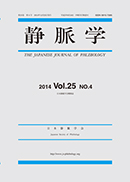Volume 25, Issue 4
Displaying 1-12 of 12 articles from this issue
- |<
- <
- 1
- >
- >|
Foreword
-
2014 Volume 25 Issue 4 Pages i-ii
Published: 2014
Released on J-STAGE: November 25, 2014
Download PDF (865K)
Original Articles
-
2014 Volume 25 Issue 4 Pages 373-380
Published: 2014
Released on J-STAGE: November 25, 2014
Download PDF (1972K) -
2014 Volume 25 Issue 4 Pages 381-385
Published: 2014
Released on J-STAGE: November 25, 2014
Download PDF (1251K) -
2014 Volume 25 Issue 4 Pages 386-390
Published: 2014
Released on J-STAGE: November 25, 2014
Download PDF (1268K) -
2014 Volume 25 Issue 4 Pages 391-395
Published: 2014
Released on J-STAGE: November 25, 2014
Download PDF (1305K) -
2014 Volume 25 Issue 4 Pages 396-402
Published: 2014
Released on J-STAGE: November 25, 2014
Download PDF (2427K)
Original Article
-
2014 Volume 25 Issue 4 Pages 403-409
Published: 2014
Released on J-STAGE: November 25, 2014
Download PDF (2041K)
Other
-
2014 Volume 25 Issue 4 Pages 410-414
Published: 2014
Released on J-STAGE: November 25, 2014
Download PDF (2797K)
Other
-
2014 Volume 25 Issue 4 Pages 415-420
Published: 2014
Released on J-STAGE: November 25, 2014
Download PDF (1800K)
Practical Phlebology
-
2014 Volume 25 Issue 4 Pages 421-429
Published: 2014
Released on J-STAGE: November 25, 2014
Download PDF (3574K)
Topics
-
2014 Volume 25 Issue 4 Pages 430-432
Published: 2014
Released on J-STAGE: November 25, 2014
Download PDF (1902K) -
2014 Volume 25 Issue 4 Pages 433-435
Published: 2014
Released on J-STAGE: November 25, 2014
Download PDF (2159K)
- |<
- <
- 1
- >
- >|
